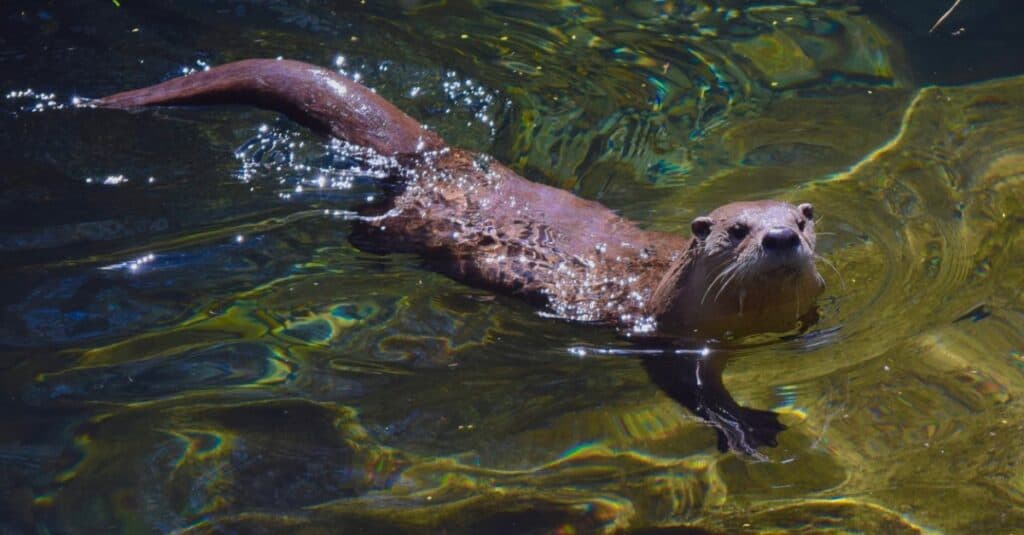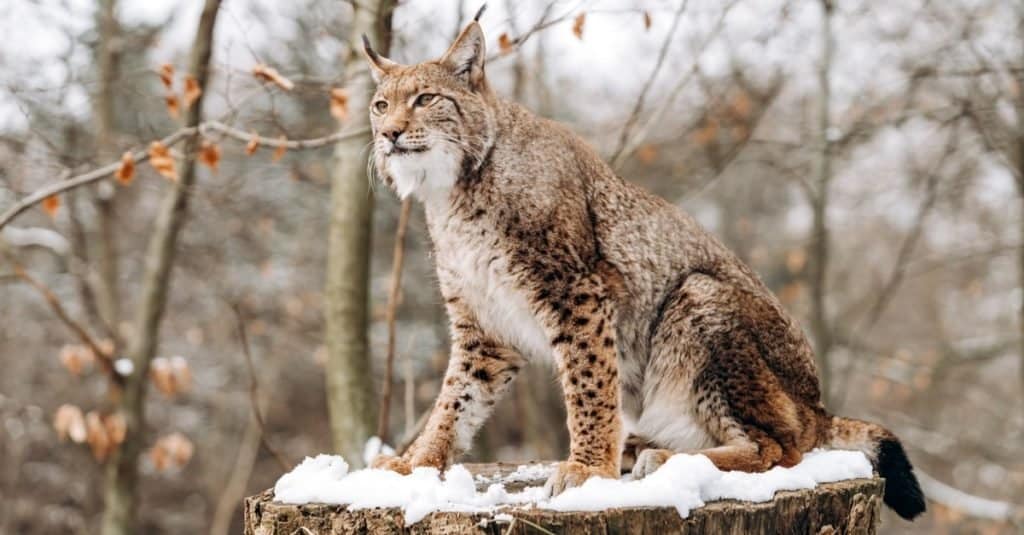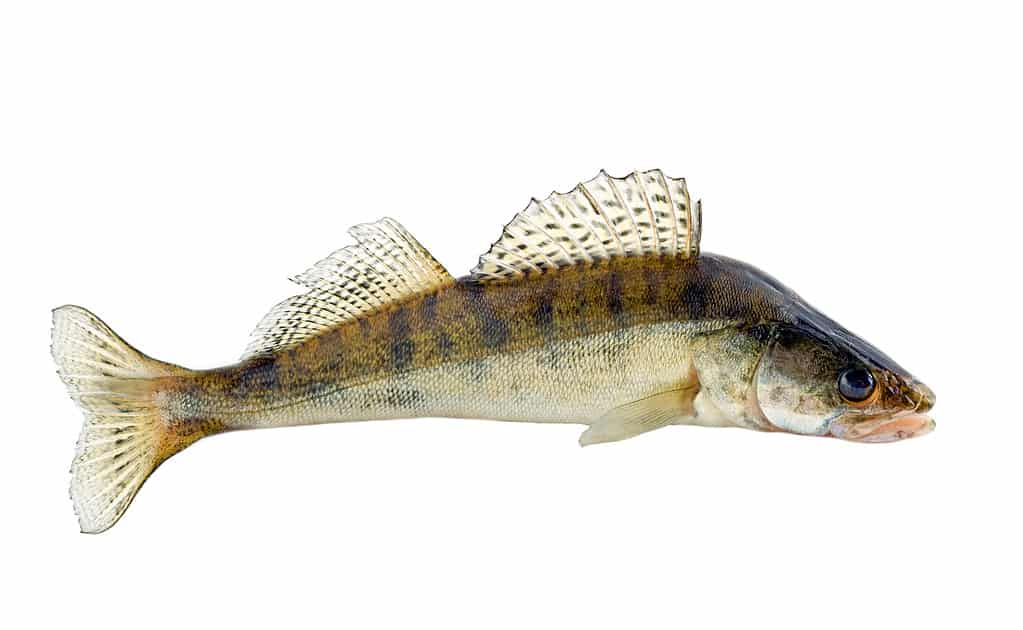
There are five Great Lakes in the US: Lake Erie, Huron, Superior, Ontario, and Michigan, which form the most extensive freshwater system in the world. Additionally, the Great Lakes span over 10,000 miles and makeup nearly one-fifth of the earth’s freshwater surface. Lake Erie is the most polluted lake in Michigan and the fourth largest of the Great Lakes.

This aerial view reveals oil-contaminated water pollution being released into Lake Erie from the steel mills in Nanticoke.
©94Mark/Shutterstock.com
History
Native Americans have called the Great Lakes region home for almost 10,000 years. Then, in the 1600s, the first Europeans settled there and started farming and hunting wildlife for animal furs. More than 35 million people call the Great Lakes basin home in the United States and Canada. These lakes are essential for irrigation, drinking water, transport, and recreation activities, including boating, hunting, wildlife watching, and fishing.
Lake Erie forms a boundary between Canada and the United States. The lake’s drainage basin is 30,140 square miles, and the lake receives water from other rivers in Detroit. Of course, the Great Lakes are home to some of North America’s most enchanting wildlife, such as the Canadian lynx, moose, gray wolf, and bald eagle. Furthermore, the lakes are also home to numerous migratory bird species and many different fish, including:
- Walleye
- Whitefish
- Trout
- Muskellunge
Wildlife Surrounding the Most Polluted Lake in Michigan
The environment surrounding the Great Lakes, including the most polluted lake in Michigan, used to be dominated by grasslands and forests, with many wetlands. Unfortunately, these areas have become smaller and smaller. However, the small areas that are still available provide habitats for several species of wildlife, including:
- Beaver
- Moose
- Gray Wolf
- River Otter
- Canada Lynx
- Little Brown Bat
- Coyote
- Many species of migratory birds, like the Northern Harrier, Double-breasted cormorant, and the endangered Kirtland’s warbler
- Fish such as Yellow perch, Lake Sturgeon, Brook trout, and Walleye
Beaver
Beavers are well known for their building skills. Notably, they will use things like stones, branches, and mud to build dams called lodges. These dams will stretch along a stream, blocking the water flow and creating a big pond. Beavers will build their homes in these dams rather than the streams.
These critters are part of a group of animals known as rodents, which includes species like squirrels, mice, and muskrats. Furthermore, there are two species of beavers. These include the American beaver and the Eurasian beaver. The American beaver occurs in North America, and the Eurasian beaver occurs in parts of Asia and Europe. Beavers have thick brown fur, short front legs, and big webbed back feet, making them good swimmers. Additionally, beavers can stay underwater for as much as 15 minutes. Furthermore, they are most active at night and eat mostly:
- Twigs
- Leaves
- Trees

Beavers have thick brown fur, short front legs, and big webbed back feet, making them good swimmers.
©iStock.com/webmink
River Otter
River otters are made for swimming. Therefore, their bodies are sleek, with webbed feet and short legs. Furthermore, their nostrils can close underwater, and their fur is thick to keep them warm. They form part of a group called Mustelids. Therefore, they are related to badgers, wolverines, stoats, mink, and weasels. Females are smaller than males.
River otters occur in streams, rivers, lakes, and estuaries; this includes the most polluted lake in Michigan. These animals are carnivores, and their diet consists primarily of:
- Snakes
- Amphibians
- Worms
- Snails
- Turtles
- Birds
- Fish
- Aquatic invertebrates

River otters occur in streams, rivers, lakes, and estuaries.
©iStock.com/Kathryn Farley
Canada Lynx
Lynx occurs in North America, Asia, and Europe. They are known for their fantastic eyesight and short tails. Additionally, these wild cats can be up to 40 inches long! Their thick fluffy paws and long legs help them navigate their harsh terrain. Furthermore, they are usually yellowish brown to gray with some darker patches, providing excellent camouflage.
These beautiful animals are related to the caracal and the bobcat. In addition, they are more active at night when hunting and live in small groups or alone. Furthermore, they can swim and climb well, which helps when sneaking up on prey. Lastly, they eat mostly small animals, birds, sheep, and deer.

Lynx occurs in North America, Asia, and Europe.
©Ewa Studio/Shutterstock.com
Kirtland’s Warbler
The Kirtland’s Warbler is one of the scarcest songbirds in North America. It is also sometimes known as the Jack Pine bird. These birds are gray and yellow and very fussy breeders. They will only breed in young jack pine forests in parts of Ontario, Wisconsin, and Michigan.
These stunning little birds spent almost 50 years on the Endangered species list. Luckily, intensive conservation, which included the suppression of Brown-headed Cowbirds, helped to increase the population to the point where they were delisted. So even though their numbers are still low, they are relatively easy to find in young jack pine forests. These migratory birds spend winter in parts of the Bahamas and are sometimes found at migration locations such as Magee Marsh, Ohio.
Walleye
The Walleye is a freshwater fish that forms part of the perch family of fish. These fish occur in North America and Canada. Besides being popular among fishermen, they prefer clean water with gravelly bottoms. These fish can weigh up to 20 pounds and measure 31 inches in length. Interestingly, females of these species are larger than males.
Walleye can appear olive-brown, black, dark brown, or golden-brown with yellow underneath and yellowish or silver on their bodies. Additionally, they have very sharp teeth as well as sharp spikes on their dorsal fins. Lastly, these fish have a lack of yellow and blue pigments in their eyes, so they see things only in shades of green and red. However, their excellent eyesight allows them to move easily through dark and murky waters.

Walleye can appear olive-brown, black, dark brown, or golden-brown with yellow underneath and yellowish or silver on their bodies.
©iStock.com/Vladyslav Danilin
Pollution
The most polluted lake in Michigan, Lake Erie, is exposed to relentless chemicals which can remain for multiple years. These chemicals include:
- Raw sewage overflows
- Industrial waste
- Mining operations
- Runoff from cities
Pollution in the Great Lakes affects over 100,00 species living in these waters. Of course, the fish that feed on the bottom of these lakes are at risk of consuming plastic. Additionally, the Great Lakes provide drinking water for more than 40 million people as well as transport and irrigation.
Micro-plastic is one of the main sources of pollution in all the Great Lakes. Unfortunately, microplastics are small remnants of plastic the same size as a grain of rice. For example, these can be found in cleaning products and toothpaste with exfoliant beads and are extremely difficult to clean up. Each year, about 22 million pounds of plastic enter the Great Lakes.
One of the other problems facing the Great Lakes is the rapid growth of algae resulting from significant amounts of nutrients from agriculture. These include phosphorus and nitrogen from fertilizers, animal manure, and soil erosion. Additionally, humans contribute to nutrient pollution. For example, our soaps and detergents run into local waterways and flow into the lakes.
How to Reduce Pollution
There are several measures we can take to help lessen pollution, including:
- Start a compost heap to avoid waste.
- Wash your car on grass to prevent runoff into the street.
- Test your soil before adding fertilizer.
- Reduce the amount of plastic you use. For example, use a reusable water bottle and stop using single-use plastics.
- Look out for biodegradable or natural material products.
- Don’t litter; pick up your trash before you leave any area.
Saving Lake Erie
In 2017 Advocate for a Clean Lake Erie and ELPC sued the United States government, mainly for neglecting to enforce the Clean Water Act that would safeguard the Lake Erie Communities. Thereafter, a federal judge concurred, and the Ohio EPA announced western Lake Erie was officially “impaired” in 2018. Yet, Ohio EPA has not supplied an adequate plan to reduce phosphorus.
In 2019 the Board of Commissioners of Lucas County and ELPC filed a similar lawsuit, this time against the Trump Administration EPA. Furthermore, they challenged the approval of an Ohio EPA decision in 2018 to make western Lake Erie a “low” priority. The same Ohio EPA has acknowledged that it does not have an effective plan to reduce phosphorus pollution. However, the court was asked to oversee a substantial strategy, including a timeline and progress report for phosphorus pollution decrease.
Where is Lake Erie Located on a Map?
Lake Erie forms a boundary between Canada and the United States. It also borders the northwestern part of Pennsylvania, the western part of New York state, the northeastern part of Ohio, and the southeast corner of Michigan.
The photo featured at the top of this post is © Sara Winter/Shutterstock.com
Thank you for reading! Have some feedback for us? Contact the AZ Animals editorial team.






